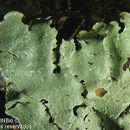Comprehensive Description
provided by Smithsonian Contributions to Botany
Pseudoparmelia caroliniana
Pseudoparmelia caroliniana (Nylander) Hale, 1974:189.
Parmelia caroliniana Nylander, 1885:614 [type collection: South Carolina, Ravenel 404 (H, lectotype; FH-Tuck, isolectotype)].
Parmelia perlata var. subrevoluta Müller Argoviensis, 1880:267 [type collection: Petropolis, Brazil, Deventer 45 (G, lectotype)].
Parmelia isidiophora Zahlbruckner, 1902:420 [type collection: Botanical Garden, Rio de Janeiro, Brazil, Höhnel 169, (W, lectotype)].
Parmelia luteola Zahlbruckner, 1909:170 [type collection: Near Barra Mansa, São Paulo, Brazil, Wettstein and Schiffner (W, lectotype)].
Parmelia wainoana Lynge, 1914:87 [type collection: Santa Anna da Chapada, Mato Grosso, Brazil, Malme 2435C (S, lectotype)].
Pyxine azorea Nylander, 1895:100 [type collection: Azores, Michel 66 (H, lectotype)].
DESCRIPTION.—Thallus closely adnate to bark, rarely on rock, 5–10 cm broad; lobes subirregular, rotund, 2–5 mm wide; upper surface plane, reticulately white-maculate and finely cracked, densely isidiate, the isidia 1–3 mm high, often branched; lower surface black, very rarely uniformly dark brown, moderately rhizinate except for a narrow naked or papillate zone along the margins. Apothecia rare, adnate, 1–3 mm in diameter, the amphithecium isidiate; spores 8, 6–8 × 13–15 μm.
CHEMISTRY.—Cortex K+ yellow, medulla K−, C−, KC+ faint rose or purple, P−; atranorin and perlatolic acid with associated unknowns.
DISTRIBUTION.—Southeastern United States, Mexico, Central America, West Indies, Venezuela, Ecuador, Brazil, Azores, Africa, and Thailand.
HABITAT.—On trees (conifers and deciduous trees) in coffee plantations, secondary forest, and pastures and rarely on rocks from sea level to 2800 m elevation.
- bibliographic citation
- Hale, Mason E., Jr. 1976. "A Monograph of the Lichen Genus Pseudoparmelia Lynge (Parmeliaceae)." Smithsonian Contributions to Botany. 1-62. https://doi.org/10.5479/si.0081024X.31

